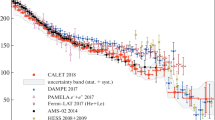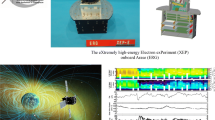Abstract
We report initial measurements from the ULECA sensor of the Max-Planck-Institut/University of Maryland experiment on ISEE-1. ULECA is an electrostatic deflection — total energy sensor consisting of a collimator, deflection analyzer and an array of solid state detectors. The position of a given detector, which determines the energy per charge of an incident particle, together with the measured energy determine the particle's charge state. We find that a rich variety of phenomena are operative in the transthermal energy regime (∼10 keV/Q to ∼100 keV/Q) covered by ULECA. Specifically, we present observations of locally accelerated protons, alpha particles, and heavier ions in the magnetosheath and upstream of the Earth's bow shock. Preliminary analysis indicates that the behavior of these locally accelerated particles is most similar at the same energy per charge.
Similar content being viewed by others
Reference
Lin, R. P., Meng, C. I., and Anderson, K. A.: 1974, ‘30- to 100 keV Protons Upstream from the Earth's Bow Shock’, J. Geophys. Res. 79, 489.
Author information
Authors and Affiliations
Rights and permissions
About this article
Cite this article
Ipavich, F.M., Gloeckler, G., Fan, C.Y. et al. Initial observations of low energy charged particles near the Earth's bow shock on ISEE-1. Space Sci Rev 23, 93–101 (1979). https://doi.org/10.1007/BF00174113
Issue Date:
DOI: https://doi.org/10.1007/BF00174113




